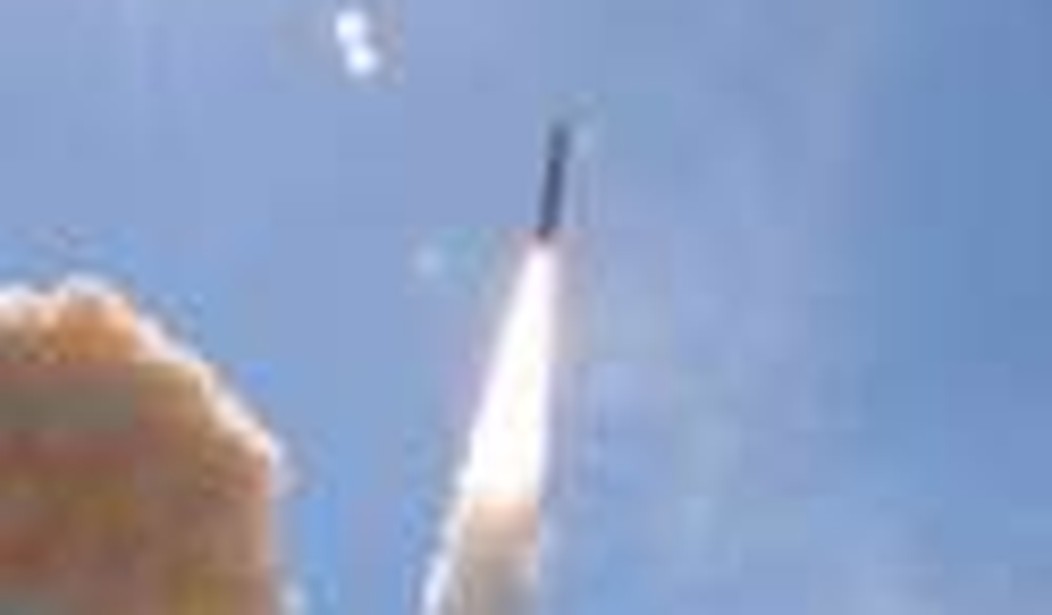Its classified payload was supposed to represent the new generation of overhead surveillance. And on December 14, 2006, a Delta II rocket blasted off from Vandenberg AFB carrying NROL-21, a satellite costing several hundred million dollars and equipped with what was thought to be the latest E-305 radar, into a 351 x 367 km orbit with a period of 92.9 minutes and an inclination of 58.5 degrees. But within minutes it was clear that something was very wrong. Its solar panels refused to deploy. Systems refused to come on and without its rockets being able to maintain altitude NROL-21’s orbit began to decay. By January 2008, the satellite had fallen to an orbit only 271 x 282 km in altitude. The increasingly dense atmosphere above the earth began to drag it down with alarming rapidity.
On board was a large quantity of unexpended rocket fuel which now represented explosive cargo. Four days later a spokesman for the National Security Council said the decaying satellite “could no longer be controlled” and would soon crash to earth at an unpredictable location. To prevent any danger to the international public, the NSC announced that “we are looking at potential options to mitigate any possible damage this satellite may cause.”
In plain words it meant the United States was going to shoot NROL-21 down. That announcement raised an outcry from Russia and critics decrying the “militarization of outer space” and accusing the U.S. of rekindling the arms race. The Pentagon, they argued, was not protecting people from satellite debris, but merely “testing its ability to target other states’ satellites.” Michael Krepon from the Henry L. Stimson Center research group in Washington, for example, called the Pentagon’s rationale for the planned shoot-down “unpersuasive.”
Space has been militarized since the days of the Nazi V-2. An Air Force academic paper recalls the Eisenhower administration’s concern that the Soviets would emplace a nuclear bomb in space. The Soviets actually deployed the Fractional Orbital Bombardment System (FOBS) in 1968. The R-36 missile had “the probable mission of providing a first-strike capability to allow the destruction of United States LGM-30 Minuteman silos and launch controls before they could retaliate.” Though warheads in orbit were retired in 1983 as a part of the SALT II treaty, they remained deployable until 1995.
The U.S. believed space was far more usefully employed for “passive” missions like surveillance and concentrated on building space-based sensors and communications links, of which NROL-21 is a recent example. However, aware of Soviet efforts to deploy weapons in outer space, the U.S. kept an eye on the sky — in fact, pioneering the observation of the Leonid meteorite showers — for threats. The first successful U.S. anti-satellite (ASAT) test took place in 1963 during the Kennedy administration as Project Mudflap. During the Nixon years the Soviets tested an ASAT system with mixed results. But Nixon, worried that the U.S. would have more to lose than the Russians in an ASAT arms race, did not respond.
It was Jimmy Carter, of all people, who responded with an air-launched ASAT program, but only with the intention of using it as a bargaining chip in arms control negotiations with the Soviets. Carter apparently never accepted the idea of fighting for the control of space. That mental leap was made by Ronald Reagan, who had no faith in the power of treaties to stop an enemy determined to use outer space for attack. Reagan felt the need for a technology to defend against Soviet threats. Unfortunately, the technology of the 1980s was not up to Reagan’s vision. The first Bush administration continued to study and fund the technology for space defense, including ASATs, until the Clinton administration revived the doctrine of reserving space as a “sanctuary” from which all weapons would be banned. President Clinton simply vetoed any money for missile defense authorized by Congress. But ironically, the huge strategic advantage inherited from the Reagan administration persuaded Clinton to shift from that lofty perch.
Although the Outer Space Treaty (OST) of 1967 is widely believed to prohibit satellite shoot-downs, it does not. The real obstacle to anti-satellite weaponry was the Anti-ballistic Missile (ABM) treaty of 1972. Banning missile defenses was “seen by many in the West as a key piece in nuclear arms control, being an implicit recognition of the need to protect the nuclear balance by ensuring neither side could hope to reduce the effects of retaliation to acceptable levels. In the East, however, it was seen as a way to avoid having to maintain an anti-missile technology race at the same time as maintaining a missile race. The U.S. at this time was allocating about 5% of their GDP on military spending. The USSR was allocating about 40% of their GDP, due to a smaller overall economic base.” Neither the United States nor the Soviet Union was entirely comfortable with its provisions. The Soviets, for example, simply violated the treaty as soon as they signed it. They deployed an ABM system around Moscow of the very type forbidden by the treaty before the ink was dry. The Reagan administration, obsessed with the idea of making nuclear weapons obsolete, pursued anti-satellite weapons research which they believed to be within the letter of the law.
When the collapse of the Soviet Union upset the carefully crafted “balance of terror” by effectively disarming America’s superpower adversary, Clinton found himself in a situation never imagined by Richard Nixon. ASATs were no longer “destabilizing” because there was no balance to destabilize. The U.S. military was able to decouple space defense from deterrence and frame it as purely prudential efforts to protect valuable assets in outer space. The emotional tipping point for the Clinton administration was provided by the need to protect the GPS satellites. The Air Force made the case for defending GPS satellites as representative of a new breed of “public utilities” in outer space. Clinton was convinced. The result was that in 1999 the DOD was able to release its first new space policy since 1987, which set out “mission areas of space support, force enhancement, space control, and force application, and the need for capabilities necessary to carry out such.”
But it was nevertheless a shock when China shot down one of its own satellites in January 2007: “a Chinese weather satellite — the FY-1C polar orbit satellite of the Fengyun series, at an altitude of 865 km, with a mass of 750 kg … destroyed by a kinetic kill vehicle traveling with a speed of 8 km/s in the opposite direction. It was launched with a multistage solid-fuel missile from Xichang Satellite Launch Center or nearby.” Air Force Chief of Staff Gen. Michael Moseley called the Chinese test “a strategically dislocating event that was on par with the October 1957 Sputnik launch.”
But if the Chinese ASAT test was destabilizing, wouldn’t the scheduled attempt by a U.S. Navy warship on NROL-21 be equally upsetting? The key difference is that the Chinese tested an anti-satellite weapon, which has offensive applications, whereas the U.S. Navy’s planned shoot-down uses the SM-3/Aegis combination meant to defend against threats at a relatively low altitude. The SM-3 does not have the inherent capability to attack another country’s satellites, only the capability to defend against inbound WMDs. ASAT weapons can be used to blind a target country by destroying its infrastructure in outer space, carrying out a space-age “Pearl Harbor” attack. The SM-3 was specifically designed to protect against a rogue missile attack or accidental launch.
Noah Shachtman at Wired describes what exactly the Navy means to do:
The plan is to fire a modified SM-3 interceptor at the satellite, “just prior to it hitting the Earth’s atmosphere,” Cartwright said. If the missile connects at that height, the collision would reduce the amount of debris that would be released into space; most of the satellite chunks would likely burn up in the air, within the first 10-15 hours, he noted. And a hit then would likely “slow the satellite down” so we can “put it in the ocean,” Gen. Cartwright added.
The modification, according to Popular Mechanics, is a software change that will enable the SM-3 to hit an object still circling the earth, instead of headed downward into the atmosphere. Unlike the Chinese weapon which destroyed FY-1C at 865 km, the SM-3 has a maximum vertical range of about 500 km, and only if it shoots straight up. But the shot will more likely be at a slant if the ship is not directly beneath the satellite when it passes, and therefore lower down. A shot on NROL-21 “just prior to it hitting the Earth’s atmosphere” will be near the Karman Line, the boundary at 100 km altitude where the atmosphere ends and space begins. Nor is there any reason to think the SM-3’s range is understated. The missiles installed on Aegis cruisers are about as big as the Mk-41 Vertical Launch System can stand. “The outgoing missiles generate enormous thrust that has to be withstood by the holding plates on the deck and the entire ship’s framework.” To reach higher altitudes requires bigger missiles mounted on either larger ships or based on land — like the Chinese system.
The Chinese strike at 865 km occurred at an altitude where many more weather and earth resource management satellites operate. For example, the European Earth Resource Satellite orbits at 780 km altitude. These are physically beyond the range of the SM-3, but well within the capability of a Chinese system. The Union of Concerned Scientists database of 872 known satellites in orbit shows that only 5.8% of all satellites fly lower than 500 km. In comparison, about 38% of all satellites are below the height of the Chinese ASAT demonstration. If America were upping the ante in ASAT platforms, they might have chosen a more impressive platform than the SM-3.
The real motives for shooting down NROL-21 are probably simple: to validate the performance of an ABM system against a realistic target. As Wired notes, “the SM-3 missile that’s supposed to do the job is at the heart of the most successful component of the American missile-defense program; unlike other, less reliable interceptors, the SM-3 has hit its targets in 11 of its last 13 tests.” Here’s a chance to see if it works for real. The other reason may be implied in the stated desire to put the remains of NROL-21 “in the ocean.” Although the satellite will probably be disintegrated on reentry in any case, the only way the U.S. can be virtually certain that none of its classified parts can be recovered is to store them in Davy Jones’ locker.
Richard Fernandez writes at the Belmont Club.










Join the conversation as a VIP Member